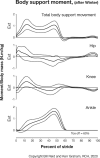Indications for gastrocsoleus lengthening in ambulatory children with cerebral palsy: a Delphi consensus study
- PMID: 33204348
- PMCID: PMC7666804
- DOI: 10.1302/1863-2548.14.200145
Indications for gastrocsoleus lengthening in ambulatory children with cerebral palsy: a Delphi consensus study
Abstract
Purpose: Equinus is the most common deformity in cerebral palsy (CP) and gastrocsoleus lengthening (GSL) is the most commonly performed surgery to improve gait and function in ambulatory children with CP. Substantial variation exists in the indications for GSL and surgical technique. The purpose of this study was to review surgical anatomy and biomechanics of the gastrocsoleus and to utilize expert orthopaedic opinion through a Delphi technique to establish consensus for surgical indications for GSL in ambulatory children with CP.
Methods: A 17-member panel, of Fellowship-trained paediatric orthopaedic surgeons, each with at least 9 years of clinical post-training experience in the surgical management of children with CP, was established. Consensus for the surgical indications for GSL was achieved through a standardized, iterative Delphi process.
Results: Consensus was reached to support conservative Zone 1 surgery in diplegia and Zone 3 surgery (lengthening of the Achilles tendon) was contraindicated. Zone 2 or Zone 3 surgery reached general agreement as a choice in hemiplegia and under-correction was preferred to any degree of overcorrection. Agreement was reached that the optimum age for GSL surgery was 6 years to 10 years and should be avoided in children aged under 4 years. Physical examination measures with the child awake and under anaesthesia were important in decision making. Gait analysis was supported both for decision making and for assessing outcomes, in combination with patient reported outcomes (PROMS).
Conclusions: The results from this study may encourage informed practice evaluation, reduce practice variability, improve clinical outcomes and point to questions for further research.
Level of evidence: V.
Keywords: cerebral palsy; consensus; equinus; gastrocsoleus lengthening; surgical indications.
Copyright © 2020, The author(s).
Figures




References
-
- Horsch A, Götze M, Geisbüsch A, et al. . Prevalence and classification of equinus foot in bilateral spastic cerebral palsy. World J Pediatr 2019;15:276-280. - PubMed
-
- Singh D. Nils Silfverskiöld (1888-1957) and gastrocnemius contracture. Foot Ankle Surg 2013;19:135-138. - PubMed
-
- Graham HK, Fixsen JA. Lengthening of the calcaneal tendon in spastic hemiplegia by the White slide technique. A long-term review. J Bone Joint Surg [Br] 1988;70:472-475. - PubMed
-
- Thomason P, Selber P, Graham HK. Single Event Multilevel Surgery in children with bilateral spastic cerebral palsy: a 5 year prospective cohort study. Gait Posture 2013;37:23-28. - PubMed
-
- Dreher T, Thomason P, Švehlík M, et al. . Long-term development of gait after multilevel surgery in children with cerebral palsy: a multicentre cohort study. Dev Med Child Neurol 2018;60:88-93. - PubMed
LinkOut - more resources
Full Text Sources
Research Materials
Miscellaneous

